Marketing project management can be daunting, especially if it’s not something you have a lot of experience with.
Yet, you may need to take on leadership responsibilities whether you’re a marketing project manager by formal job title or not.
Over the past year, marketing teams report having been asked to do more using the same resources. It’s important to know what it takes to be effective: where to cut corners, how to motivate your team, and how to master time management to keep campaigns on track.
Unsure where to start?
This post will cover the skills and processes you need to get off on the right foot. But first…
Claim Your Marketing Project Management Templates Bundle
This free bundle comes with spreadsheets to help you manage your entire marketing process and get the most out of your team.
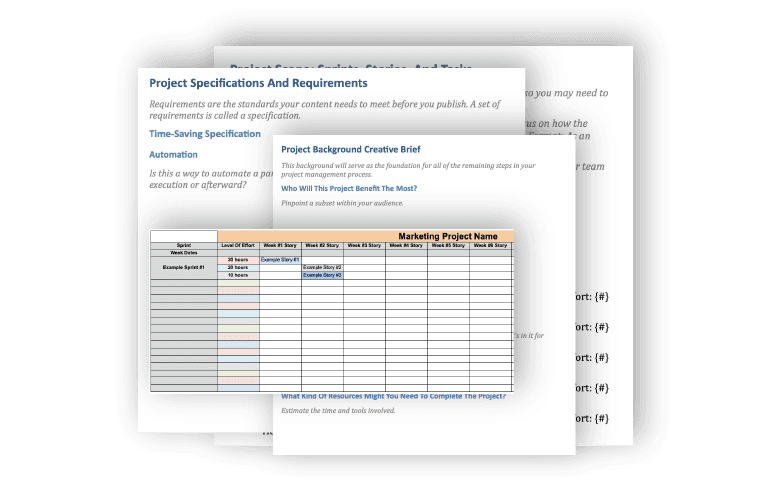
Claim Your Project Management Template Bundle
Plus, join our email list to stay up to date.
Success! Your download should start shortly. Or you can download it manually here.
Table of Contents
- What Marketing Project Management Is (… And Isn’t)
- What Does a Marketing Project Manager Do?
- What Skills Does a Marketing Project Manager Need?
What Marketing Project Management Is (… And Isn’t)
Marketing project management is the planning, organization, execution, tracking, and optimization of marketing strategy.
In other words: project managers (PMs) oversee projects from start to finish, making sure their teams hit all deadlines along the way.
While the above are, of course, the duties of a designated PM, other marketing team members can also be responsible for them. That’s because marketing project management isn’t just a job title; it’s a set of responsibilities.
But whether you hold the job title or the responsibilities, remember that neither warrant micromanagement nor total control.
A good marketing project manager:
- Facilitates productivity, but doesn’t try to babysit other professionals.
- Doesn’t try to tackle decision-making alone, but instead delegates and seeks continuous input from their team.
Embracing the project management process we’ll talk about shortly can help you to do both and lead your team to success.
What Does a Marketing Project Manager Do?
PM’s are responsible for overseeing the execution of marketing plans from end to end and encompasses many duties. A marketing project manager needs to fulfill a few basic things:
- Scoping projects accurately, developing the foundation for project workflows, and setting reasonable deadlines.
- Delegating tasks to the right people and teams, in the right order.
- Making sure everyone has what they need to get their work done well and on schedule.
- Facilitating clear communication between stakeholders to keep projects on track and deliver a cohesive, effective campaign.
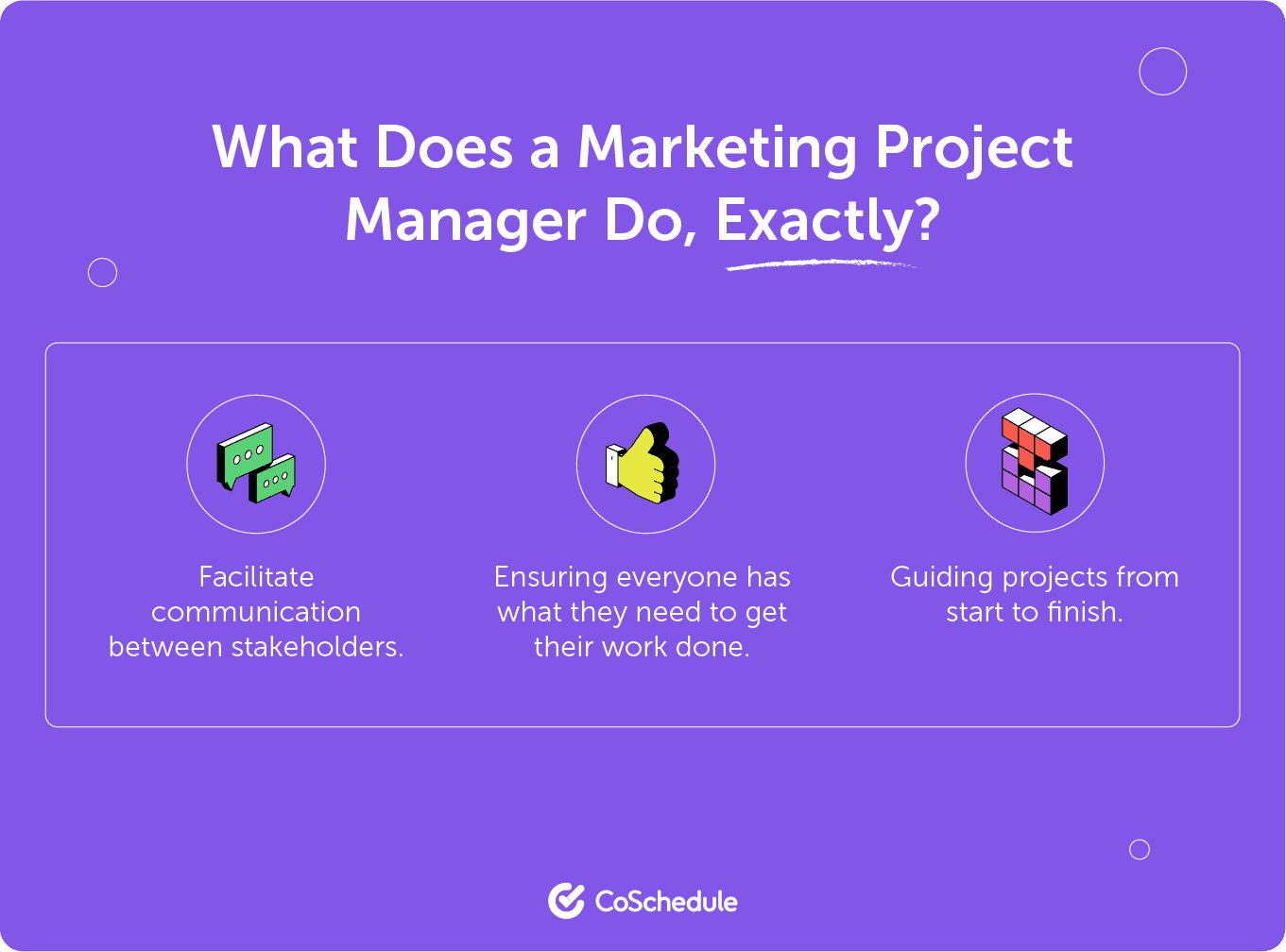
With so many moving parts, especially for complex projects, efficient project management takes skill.
What Skills Does a Marketing Project Manager Need?
To be successful as the project manager of a marketing campaign, you need a mix of soft and technical skills.
Necessary soft skills include strong:
- Written and oral communication so that everyone’s clear on project details.
- Conflict resolution to quickly resolve disagreements or misunderstandings that could threaten the progress or success of a project.
- Strong leadership to provide structure, keep execution streamlined, and motivate team members to do their best work.
- Time management to keep yourself and everyone else moving forward. (Spoiler alert: High-impact tasks should receive the most attention.)
- Subject matter expertise for a realistic idea of the project scope, a well-rounded understanding of the steps leading to the end goal, and better communication with stakeholders.

“What about technical skills?” I hear you ask.
This isn’t necessarily a complete list, but it covers the major competencies you’d do well to develop. Consider this a short list of what you need to get by (which is really what we’re going for here).
- Task management to develop strategic plans of action to get the desired outcomes.
- Timeline planning, which includes setting reasonable deadlines that allow for unexpected delays and managing stakeholder expectations. On any given project, you’ll likely have multiple people working on different pieces of the greater whole.
- Familiarity with marketing project management tools like CoSchedule. You’ll have one dashboard to store project info and to-dos. The result? Frictionless teamwork and campaign execution.
- Resource management, including time, money, and people to get the work done according to plan.
With this understanding of what effective marketing project management entails, let’s get into the practical steps for leading a project.
Step 1: Understand the Project
The mark of bad project management is “lack of insight, foresight, and knowledge of what it entails to drive your team to produce excellent results,” according to Thomas Mirmotahari of PerkUp.
“Smart project planning includes a thorough understanding of the goals of the project against a system of execution that supports meeting those deadlines and targets at measurable intervals.”
To gain that understanding for your next campaign, consider the following:
- What is the marketing team working on? If you can’t come up with a bird’s eye view description of the project, it’s a telltale sign you need more clarity before moving ahead.
- Who’s working on the project? Consider the expertise each member of your marketing team (or other teams) has to offer. Not to mention what resources they need and the best leadership style for them.
- When must the project be completed? Ideally, you should pad both task and overall project deadlines to give you and your team a buffer if a portion of the project takes longer than expected.
Once you’re clear on these three aspects of the project you’re leading, you can safely move on to the next stage.
Step 2: What Are the Team’s Goals?
Next, it’s time to dig deeper into what your team will do—and more importantly, the purpose behind it.
Ask yourself these questions:
- What are the project deliverables? For example, these could include content for an upcoming email marketing campaign or the creation of assets to support a new product launch.
- What’s the main project objective? Besides outlining what the team’s output will be, define the intended impact. Brand awareness and lead generation are common goals.
- What key performance indicators (KPIs) will be measured? It’s tough to accurately judge success in marketing without tracking the right metrics and setting benchmarks to measure against. So, determine which KPIs align with the project goals, note current performance, and set a SMART goal for improving those metrics.
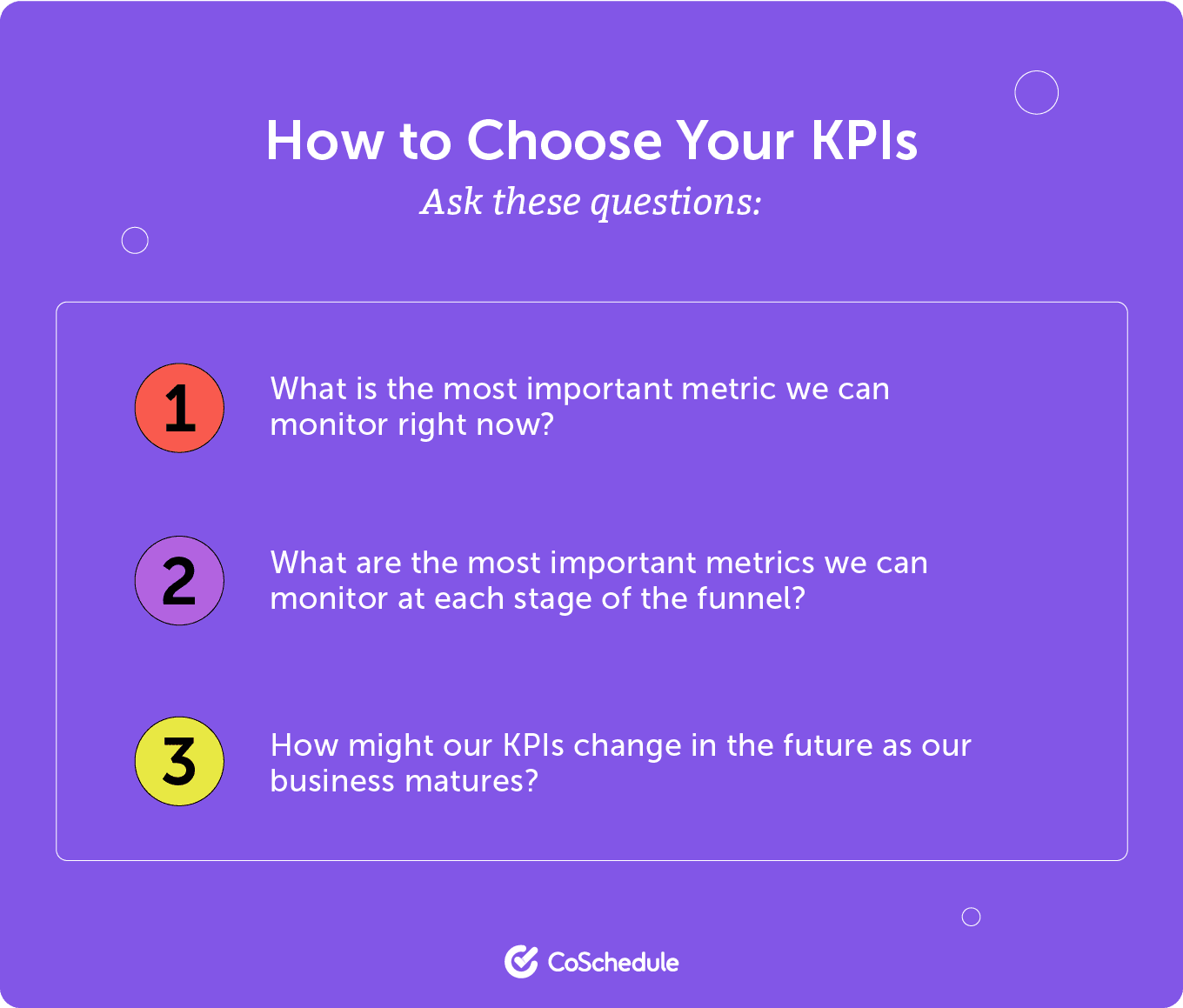
“A well-thought-out strategy can help you avoid many potential mistakes. Planning well ahead of time can allow you to avoid wasted time or effort. It can also allow you to build a solid framework for your project, which makes it easier to stay on track and move forward with your work.” —David Rowland, Head of Digital Marketing at EcoOnline
Building a strong foundation for your project is half the battle. Don’t rush. Take your time with this step and subsequent planning stages.
Step 3: Map Out a Project Timeline
Another key part of marketing project planning is mapping out a reasonable project schedule.
In fact, Jonas van de Poel, Head of Content Marketing at Unmuted, pegged it as the most overlooked project management skill: “Marketing is a creative, complex process. When you kill this process with deadlines that are unnecessarily tight, this will eventually show in your results.
“Any smart marketing project manager will add buffers to allow room for those magical final touch edits. It’s this room to breathe that separates successful and unsuccessful marketing project management.”
So how can you make sure that the deadlines you set are attainable and contribute to the success of the project?
Follow this process and create a marketing project roadmap:
- Identify required tasks for every team member. This is where subject matter expertise, knowing your team, and defining deliverables come in handy. You can’t assign the right tasks to the right people if you’re in the dark about any or all of those things.
- Estimate how long each task will take. Pad project schedules slightly to allow for unexpected delays. A good rule of thumb: tack two to three days onto to task turnaround times and one to two weeks to the final deadline.
- Identify dependencies for each task. What work must be done first so that other tasks can be completed successfully? Figuring this out can prevent delays from skipped steps, having to redo work that was done without the necessary inputs or from team members being forced to wait for resources.
- Put tasks into chronological order. With all tasks outlined and turnaround times set first, it’s much easier to avoid skipping steps or assigning tasks in the wrong order.
You may also want to define milestones—key points in the project—that can keep you oriented as the project progresses. In any case, once the timeline is set, you can begin organizing the details for your team to review.
Step 4: Explain the Project With a Creative Brief
Creative briefs pull pertinent project info—like who needs to do what and when—into one place. It’s is a simple outline of everything the project will entail, including:
- Project description
- Deliverables
- Project goals
- Team members and points of contact
- Project workflow and timeline

Depending on the project, you may also want to add details such as:
- Target audience description
- Messaging and tone of voice guidance
- Project budget if you’re prepping for a paid campaign
Use a creative brief template that you can easily fill in for each new project so that you’re not starting from scratch every time. Not only will this save you precious time, but the consistent format will stop any important details from going awol.
The good news? A content brief doesn’t need to be overly complex. Generally, a Word doc or PowerPoint slidedeck is all you need.
Here’s an example of what a one might look like (based on the actual template CoSchedule uses internally):
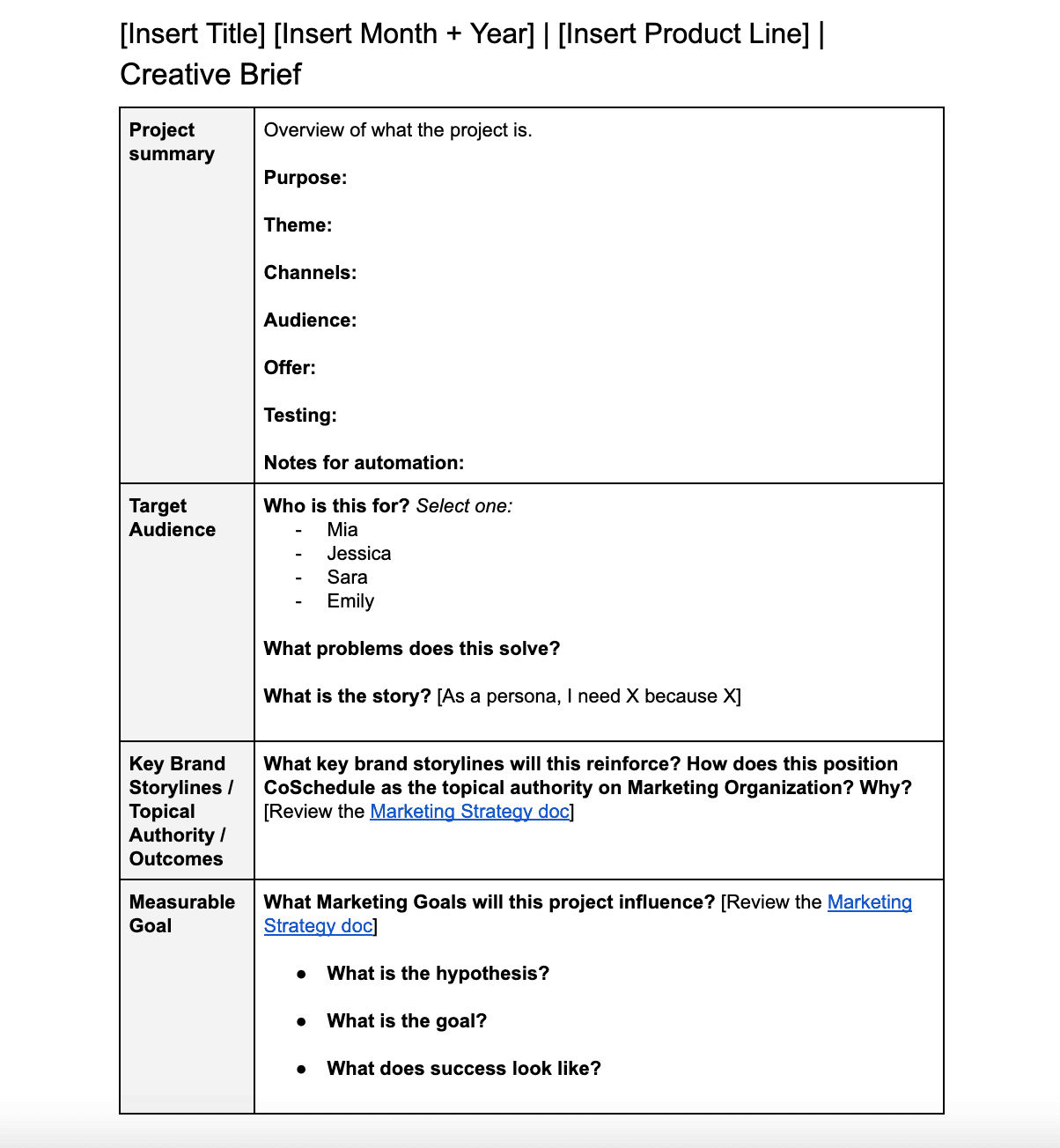
Step 5: Get Organized With Marketing Project Management Software
With all of the project details outlined, you can then add them to your project management platform of choice.
Not currently using one? Chaenara O’Brien, Head of Strategy at Thought Bakery, has this advice for you: “If you’re not using a project management tool to optimize your marketing activities at the moment, you should evaluate whether your future marketing goals can handle the risk of things falling into chaos without a reliable system.”
Speaking of the importance of knowing how to use tools like CoSchedule efficiently, Chaenara continued: “They are priceless as they help bridge the gap between a long list of tasks and the pipeline of effort you still have available within your resource allocation.”
Research backs this up: 83% of successful marketing teams use collaboration tools (compared to just half of the least successful.)
Jump into your project management platform (whichever you’re using is fine, but for demonstration purposes, this post is going to use CoSchedule) and start creating entries for each phase and mark off deadlines.
Once have everything placed, you’ll be able to switch between viewing your projects and campaigns on the CoSchedule marketing calendar:
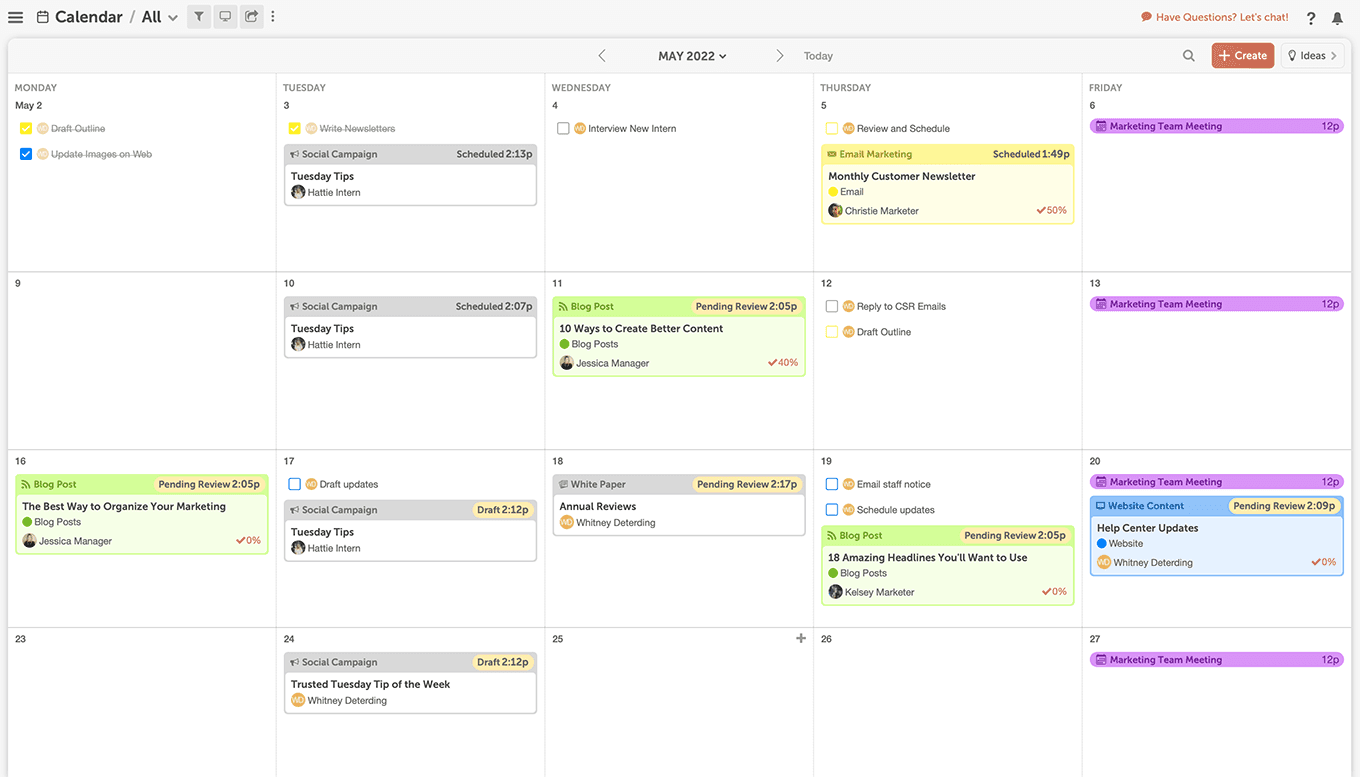
Planned your tasks somewhere else, such as in a Google Sheet or another project management tool? The bulk import functionality can save you time. Task template functionality is built to speed up task list creation, and team collaboration features for sharing progress in real-time.
Plus, choose from hundreds of CoSchedule integrations to streamline workflows and improve team efficiency. With Zapier, you can quickly and easily connect popular apps such as Mailchimp, Google Sheets, Shopify, and more.
The goal is to have as many tasks as possible in one marketing calendar. That way, the project team isn’t needlessly switching between apps—which is both time-consuming and risky.
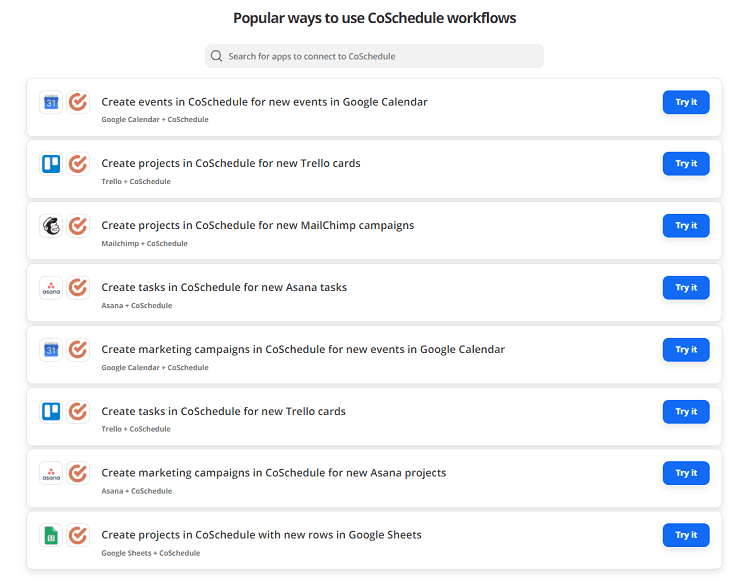
Talk about making marketing project management easier.
Step 6: Schedule Meetings to Track Project Progress
Speaking of progress, tracking how well your plan is going is crucial for the successful management of marketing projects. (That’s especially true if your team works remotely.)
How you should go about it depends on your company and team.
If your company uses agile marketing, then daily standups may be sufficient to track advancement toward key milestones. Otherwise, it may make sense to schedule more structured recurring meetings—for example, weekly meetings—to get status updates from various teams.
No matter what type of meetings you settle on, though, the important thing is that you make the most of them. (Let’s face it: most meetings could have been an email.)
Create an agenda, and instead of focusing solely on progress to date, use meetings to anticipate and prepare for potential roadblocks. If you do, it’ll be easier to give team members what they need to finish their work successfully and on time.
Step 7: At the End, Review What You Learned
Once the project is done, don’t anxiously move on to the next.
Take time to reflect—both as a team and as the marketing project manager—on these questions:
- What went well? And don’t just think about the KPIs you tracked; also consider unexpected wins and the factors that contributed to them. Write down what went well as far as team collaboration, communication with stakeholders, the project workflow, and so on.
- What didn’t go so well? Think about the objectives you didn’t meet, areas in which your teamwork could’ve been better, and where you fell short as a PM.
- What could be improved in the future? Reflecting on past projects isn’t of much use if you don’t put the lessons you learn into practice. So, turn your observations into practical steps that’ll get better results on future projects.
By having open discussions about these questions and doing an honest evaluation of your performance as a project manager, you can exponentially increase your (and your team’s!) success on future campaigns.
Improve Your Marketing Project Management Skills
No matter your role in the marketing department, learning to manage projects more can serve you and your company well.
Take every opportunity to practice the skills, processes, and tools we’ve discussed (CoSchedule included). Map out timelines and key dates; set clear responsibilities for each marketing team member; review projects you’ve managed to see where you can improve next time.
After all, the success of a campaign largely depends on the organization of its leader. It’s down to you to make the next one a winner.
The post Marketing Project Management: How to Organize Projects in 7 Steps appeared first on CoSchedule Blog.




